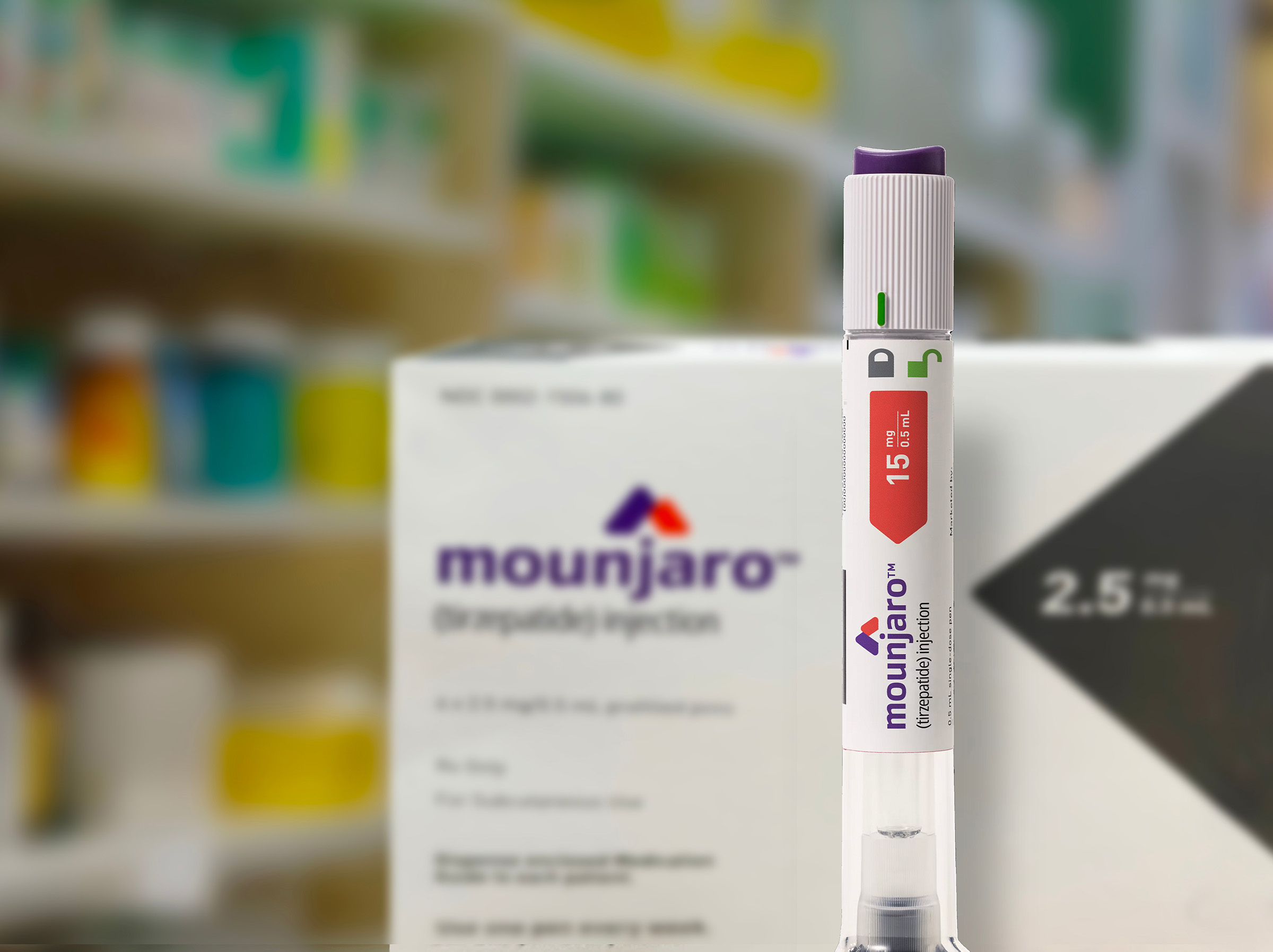
Published on December 8, 2023
Read Time: 6 Minutes
Three Things to Know
- Mounjaro (tirzepatide) was FDA-approved in spring 2022 for managing type 2 diabetes. The medication mimics two digestive hormones (GLP-1 and GIP), resulting in lower blood sugar.
- Mounjaro is administered via an injection once a week, and common side effects include gastrointestinal issues, weight loss and increased heart rate.
- To learn if you are a potential candidate for this medication, schedule a visit with your healthcare provider.
More than 30 million Americans have type 2 diabetes, the most common form of diabetes. Type 2 diabetes is a chronic and progressive condition in which the body does not make or use insulin properly, leading to high levels of glucose (sugar) in the blood. (Insulin is a naturally occurring hormone made by your pancreas that helps your body use sugar for energy.)
In the spring of 2022, the US Food and Drug Administration (FDA) approved the medication Mounjaro (generic name: tirzepatide) to improve blood sugar control in adults with type 2 diabetes, in addition to diet and exercise. Please note that people with type 1 diabetes should not take Mounjaro.
At a past Phelps Health diabetes support group meeting, Phelps Health Clinical Pharmacy Coordinator Tyler Craft, PharmD, BCPS, answered frequently asked questions about Mounjaro.
What is Mounjaro? And how does it work?
Mounjaro belongs to a class of medications that mimic two hormones involved in digestion, which are glucagon-like peptide-1 (GLP-1) and glucose-dependent insulinotropic polypeptide (GIP).

A delicate balance: Glucagon is a hormone that your pancreas makes to help regulate your blood sugar levels. Glucagon increases your blood sugar level and prevents it from dropping too low, whereas insulin, another hormone, decreases blood sugar levels. For people without diabetes, insulin and glucagon work as a team, to keep blood sugar in balance.
In a person without diabetes, the process of eating signals the brain and small intestines to release GLP-1 and GIP. These hormones then signal the pancreas to release insulin. Finally, insulin works throughout other cells in the body to decrease blood sugar levels and promote the metabolism of sugars.
In the case of diabetes, however, the effects that GLP-1, GIP and sugar have on the pancreas are weakened or absent.
Enter Mounjaro, which is designed to fool your body into thinking that the drug is GLP-1 and GIP. By mimicking these hormones, the drug does the following:
- Increases insulin secretion, resulting in lower blood sugar
- Decreases glucagon production (For those with diabetes, unchecked glucagon production can result in blood sugars that are too high.)
- Slows gastric emptying (process by which the contents of the stomach are emptied into the duodenum, the first part of the small intestine).
Furthermore, by mimicking GLP-1 and GIP, Mounjaro can decrease a person’s appetite and food intake, which often leads to weight loss.
Why is insulin so important?
This vital (can’t live without) hormone allows sugar to enter cells throughout the entire body, supporting the following:
- Mood and cognition (brain processes)
- Energy production
- Muscle function
- Proper digestion
- Lowering of blood sugar
- Healthy metabolism
Most type 2 diabetic patients produce some insulin, but their cells often don’t respond well. A deficiency in the pancreas also can be a contributing factor in type 2 diabetes.
How is Mounjaro administered?
Mounjaro is administered once a week via subcutaneous injection (injected into the fatty layer of tissue just under the skin).
Keep the following guidelines in mind when injecting the prescription:
- Administer the injection the same day each week.
- Mounjaro can be given any time of day.
- Rotate injection sites: ideal sites include the abdomen, thigh or upper arm.
- Do NOT mix with other injectable medications or products.
- Mounjaro does NOT require priming.
For those with a fear of needles, the needle retracts into the plastic after use, remaining unseen.
What do I need to know before taking this medication?
- Delayed gastric emptying may alter the absorption of other medications.
- Taking Mounjaro requires careful monitoring for GLP-1 overexposure which may cause pancreatitis (inflammation of the pancreas), especially following a bariatric (weight loss) surgery.
- Stay hydrated to protect your kidneys, especially if you are battling nausea or vomiting.
What are the potential side effects?
Potential side effects can include, but are not limited to, the following:
- Acute kidney injury (typically due to nausea and vomiting)
- Diabetic retinopathy (damage to the retina, the light-sensitive layer of tissue at the back of the eyeball)
- Gallbladder dysfunction
- Abdominal pain and/or bloating, constipation, diarrhea, nausea and/or vomiting
- Decreased appetite, which can lead to weight loss
- Increased heart rate
- Medullary thyroid carcinoma (cancer of the thyroid gland). The FDA reports that the drug can cause thyroid tumors in rats. You should NOT take this medication if you or a family member have a history of this cancer.
- Pancreatitis (more common for those who have had bariatric surgery)
On side effects: The most common side effects seen in patients are GI (gastrointestinal) symptoms, including nausea, vomiting, constipation and/or diarrhea. For this reason, healthcare providers typically gradually increase the dosage. At some point, quality of life must come into play. Your blood sugar may be great, but if you are constantly vomiting or nauseated, you may want to consider another medication.
Seek immediate medical attention if you experience any of the following symptoms:
- Neck mass
- Difficulty breathing
- Hoarseness
- Inability to urinate
- Blood in the urine
- Significant weight gain
- Upper right abdominal or shoulder pain
- Severe bloating with fever/chills
- Yellow skin or eyes
- Severe abdominal pain or back pain
- Vomiting
- Dizziness or passing out
- Rapid heart rate
- Change in vision
- Low blood sugar
- Signs of an allergic reaction
Is Mounjaro the same as Trulicity?
While the medications are made by the same company, there is one big difference. Trulicity (generic name: dulaglutide) is a single-action medication that mimics the hormone GLP-1, while Mounjaro is a dual-action medication and mimics the hormones GLP-1 and GIP. In theory, by using Mounjaro, you are getting more bang for your buck. Before making any changes, however, you should talk with your healthcare provider to discuss the pros and cons of each specific medication.
What other medications fall under the GLP-1 category?
- Ozempic (generic name: semaglutide): available orally or subcutaneously
- Bydureon (generic name: exenatide): available subcutaneously, with immediate- and extended-release versions
- Victoza (generic name: liraglutide): available as a subcutaneous injection alone, or in combination with insulin
- Adlyxine (generic name: lixisenatide): available as a daily subcutaneous injection
Who is a good candidate for this type of medication?
Current research suggests that GLP-1 medications are recommended early on in the treatment of type 2 diabetes, even before insulin. In FDA trials comparing Mounjaro to other diabetes medications, patients who received the maximum recommended dose of Mounjaro lowered their HbA1c (blood sugar level) by 0.5% more than with semaglutide (brand name: Ozempic) and 1% more than with insulin glargine (a long-acting insulin).
Mounjaro may be a good fit for people with type 2 diabetes and the following conditions:
- Cardiovascular (heart) disease (currently have or at risk for)
- Obesity
Does insurance cover Mounjaro?
Some insurance providers can help to cover the cost of Mounjaro. However, as it is a relatively new drug, not all insurance plans will cover the medication. In most cases, insurance covers only a person with type 2 diabetes. To find out your financial responsibility, contact your insurance provider.
A word of caution
- Evidence suggests you should not use Mounjaro alongside DPP-4 (dipeptidyl peptidase-4) inhibitors, such as Januvia (generic name: sitagliptin).
- Combination therapy is common, but may require a dose reduction of insulin, metformin or sulfonylureas to avoid hypoglycemia (low blood sugar).
Is Mounjaro also approved for weight loss?
On November 8, 2023, the FDA approved Mounjaro (branded as Zepbound) for chronic weight management in overweight and obese adults with at least one weight-related condition (such as high blood pressure, type 2 diabetes or high cholesterol.) This approval is in addition to a reduced-calorie diet and increased physical activity. Learn more about the FDA’s decision and how they define obesity.
The Bottom Line
While Mounjaro is proving to be a game changer in treating type 2 diabetes and obesity, this drug comes with a considerable list of side effects. The decision to take this prescription should not be taken lightly. Information in this article is not intended for diagnosing or prescribing purposes. If you have any specific questions or concerns about your health, please talk to your primary care provider (PCP). If you don’t have a PCP, refer to our list of primary care providers.